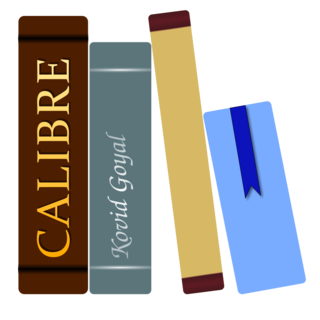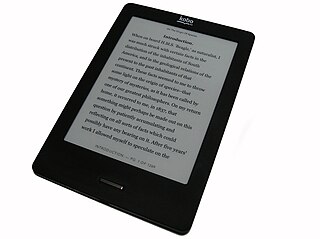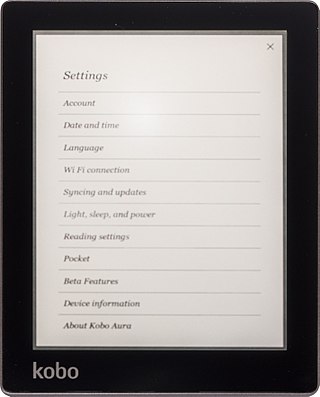An e-reader, also known as an e-book reader, is a portable electronic device that is designed primarily for the purpose of reading e-books and periodicals. E-readers have a similar form factor to a tablet; usually use electronic paper resulting in better screen readability, especially in bright sunlight; and have longer battery life when compared to a tablet. An e-reader's battery will typically last for multiple weeks. In contrast to an e-reader, a tablet has a screen capable of higher refresh rates which make them more suitable for interaction such as playing a video game or watching a video clip.

The Sony Reader (ソニー・リーダー) was a line of e-book readers manufactured by Sony. The first model was the PRS-500 released in September 2006 and was related to the earlier Sony Librie, the first commercial E Ink e-reader in 2004 using an electronic paper display developed by E Ink Corporation. The last model was the PRS-T3, after which Sony announced it would no longer release a new consumer e-reader.

An e-reader, also called an e-book reader or e-book device, is a mobile electronic device that is designed primarily for the purpose of reading digital e-books and periodicals.

Adobe Digital Editions is an e-book reader software program from Adobe. It is used for acquiring, managing, and reading e-books, digital newspapers, and other digital publications. The software supports EPUB and PDF. It implements a proprietary scheme of digital rights management (DRM) which, since the version 1.5 release in May 2008, allows document sharing among multiple devices and user authentication via an Adobe ID. Digital Editions is a successor to the Acrobat eBook Reader application.
The following is a comparison of e-book formats used to create and publish e-books.
Amazon Kindle is a series of e-readers designed and marketed by Amazon. Amazon Kindle devices enable users to browse, buy, download, and read e-books, newspapers, magazines, Audible audiobooks, and other digital media via wireless networking to the Kindle Store. The hardware platform, which Amazon subsidiary Lab126 developed, began as a single device in 2007. Currently, it comprises a range of devices, including e-readers with E Ink electronic paper displays and Kindle applications on all major computing platforms. All Kindle devices integrate with Windows and macOS file systems and Kindle Store content and, as of March 2018, the store had over six million e-books available in the United States.
Fictionwise, owned by Barnes & Noble since 2009, was one of the largest electronic book sellers in North America with an estimated 1.5 million ebook content units sold in 2008. Fictionwise sold both DRM-encrypted and unencrypted (DRM-free) ebooks in various formats that were compatible with computers as well as a wide range of eBook devices, PDAs, and Smartphones.

EPUB is an e-book file format that uses the ".epub" file extension. The term is short for electronic publication and is sometimes stylized as ePUB. EPUB is supported by many e-readers, and compatible software is available for most smartphones, tablets, and computers. EPUB is a technical standard published by the International Digital Publishing Forum (IDPF). It became an official standard of the IDPF in September 2007, superseding the older Open eBook (OEB) standard.
PRC is a container format for code databases in Palm OS, Garnet OS and Access Linux Platform. Its structure is similar to PDB databases. Usually, a PRC file is a flat representation of a Palm OS application that is stored as forked database on the PDA.
Cybook Opus is a 5-inch e-reader, specially designed for reading e-books and e-news. It is produced by the French company Bookeen.

Calibre is a cross-platform free and open-source suite of e-book software. Calibre supports organizing existing e-books into virtual libraries, displaying, editing, creating and converting e-books, as well as syncing e-books with a variety of e-readers. Editing books is supported for EPUB and AZW3 formats. Books in other formats like MOBI must first be converted to those formats, if they are to be edited. Calibre also has a large collection of community contributed plugins.

An ebook, also spelled as e-book or eBook, is a book publication made available in electronic form, consisting of text, images, or both, readable on the flat-panel display of computers or other electronic devices. Although sometimes defined as "an electronic version of a printed book", some e-books exist without a printed equivalent. E-books can be read on dedicated e-reader devices, also on any computer device that features a controllable viewing screen, including desktop computers, laptops, tablets and smartphones.

The Nook 1st Edition is the first generation of the Nook e-book reader developed by American book retailer Barnes & Noble, based on the Android platform. The device was announced in the United States in October 2009 and was released the next month. The Nook includes Wi-Fi and AT&T 3G wireless connectivity, a six-inch E Ink display, and a separate, smaller color touchscreen that serves as the primary input device. In June 2010 Barnes & Noble announced a Wi-Fi-only model of the Nook. On June 5, 2018 Barnes and Noble announced support for logging in to BN.com and adding new content to the device will end on June 29, 2018. The second-generation Nook, the Nook Simple Touch, was announced on May 25, 2011 with a June 10 release date.

The Kobo Touch is the third generation of the Kobo e-reader device designed by Kobo Inc. It was revealed on 23 May 2011 and was released in the U.S. on 10 June 2011 at a price of $129.99.

The Amazon Fire, formerly called the Kindle Fire, is a line of tablet computers developed by Amazon. Built with Quanta Computer, the Kindle Fire was first released in November 2011, featuring a color 7-inch multi-touch display with IPS technology and running on Fire OS, an Android-based operating system. The Kindle Fire HD followed in September 2012, and the Kindle Fire HDX in September 2013. In September 2014, when the fourth generation was introduced, the name "Kindle" was dropped. In later generations, the Fire tablet is also able to convert into a Smart speaker turning on the "Show Mode" options, which the primary interaction will be by voice command through Alexa.

The Kobo Aura is the fifth generation of E-book readers designed and marketed by Kobo Inc. It was revealed 27 August 2013 at Kobo's Beyond the Book Event in New York City, along with three new Kobo Arc devices. Available for pre-order the same day, it cost $149.99 USD/CAD.

OfficeSuite is a cross-platform office suite application developed by MobiSystems. It has versions for Android, iOS and Microsoft Windows (PC) and adds extensive PDF abilities to its compatibility with the most frequently used Microsoft Office file formats. The software has over 220 million downloads on Google Play and is among the top Android business applications.

FBReader is an e-book reader for Linux, Microsoft Windows, Android, and other platforms.
Kindle File Format is a proprietary e-book file format created by Amazon.com that can be downloaded and read on devices like smartphones, tablets, computers, or e-readers that have Amazon's Kindle app. E-book files in the Kindle File Format originally had the filename extension .azw; version 8 (KF8) introduced HTML5 & CSS3 features and have the .azw3 extension, and version 10 introduced a new typesetting and layout engine featuring hyphens, kerning, & ligatures and have the .kfx extension.

Foliate is a free and open-source program for reading e-books in Linux. In English, foliate is an adjective meaning to be shaped like a leaf, from the Latin foliatus, meaning leafy.












